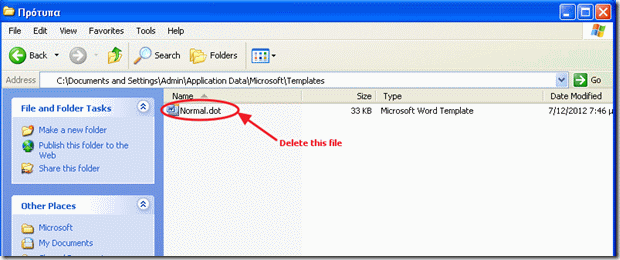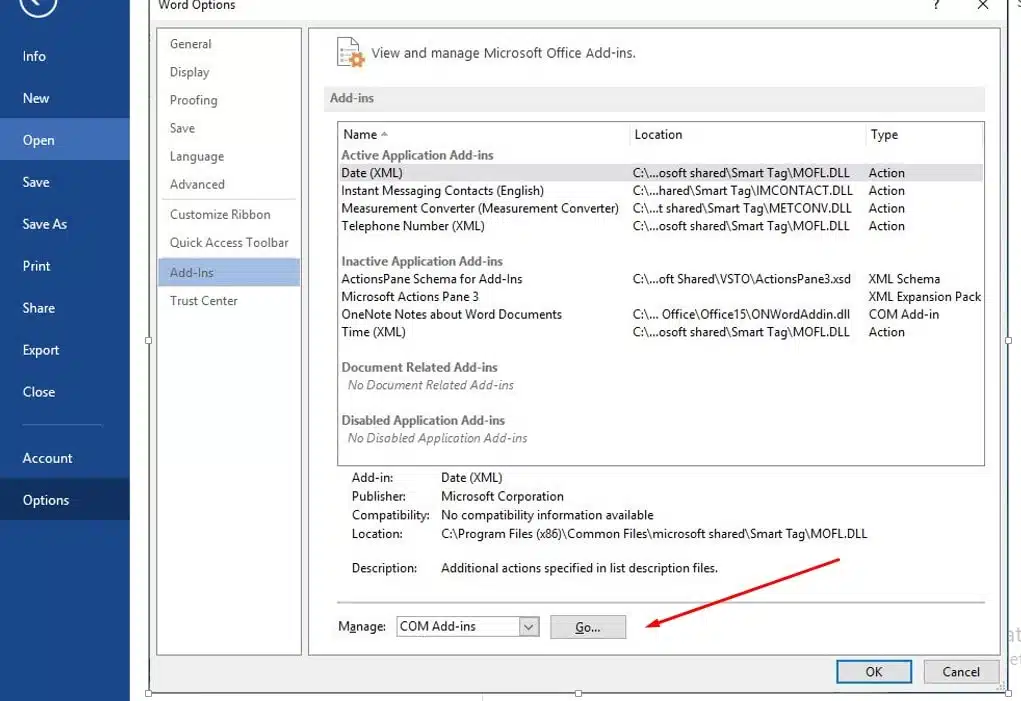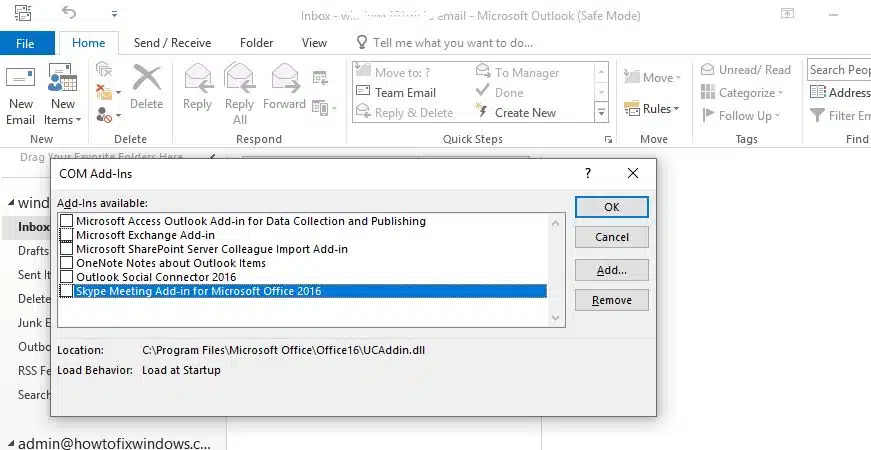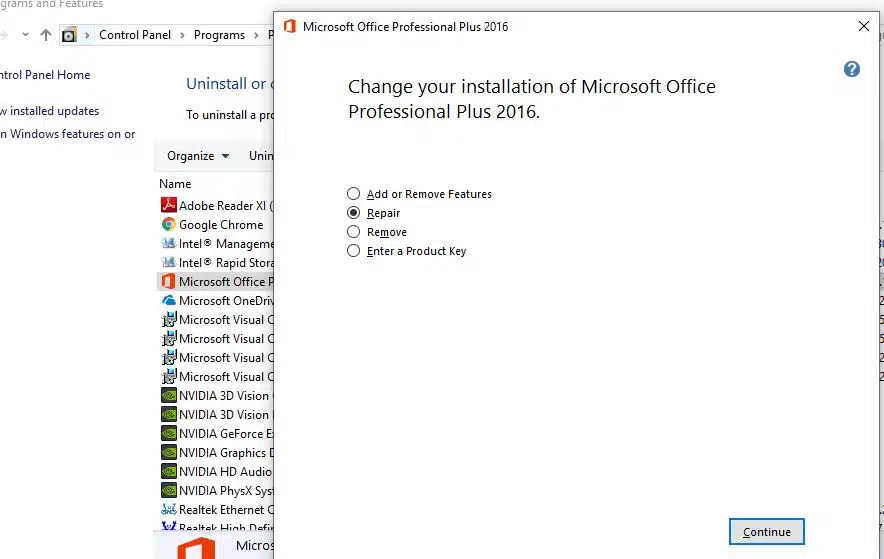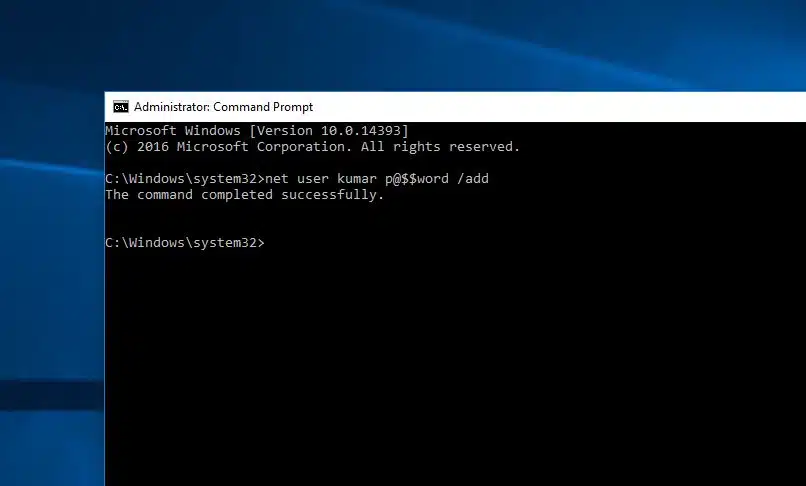Microsoft Word is one of the popular text processing applications available. Though there are many alternate apps, Word is an ultimate document app due to universal use. However, slow performance of Microsoft Word is quite common on many computers due to various reasons. This may result in reduced productivity for business professionals and normal computer users. In this article let us explain how to fix slow Word when opening, typing and saving documents to speedup productivity.
Related: How to fix slow Microsoft Excel and speedup your productivity.
Fix Slow Microsoft Office Problems
Here are the fixes to solve the performance problem with Microsoft Word.
- Deleting default template file
- Disable graphics acceleration in Word settings
- Use registry editor to disable graphics acceleration
- Install updates
- Update your OS
- Reinstall Microsoft Office
- Delete temporary files
- Optimize the document
- Open Word in safe mode
- Check locked files
- Disable add-ins
Method #1: Delete Normal.dot File
Microsoft Word uses template files to create documents. Normal.dot is the global template file that Word uses for creating a blank document file. This essentially means, the template file is always in use when Word is in use. Word also stores all style related settings, such as font size and font type in this template. So, problematic or corrupted ‘Normal.dot’ template can cause slow performance when opening or closing your documents.
An effective solution is to delete the Nomal.dot or Normal.dotm template file. You don’t need to worry about deleting this file as Word will recreate a fresh Normal.dot file when you open the application. However, it is a bit tricky task, since Normal.dot or Normal.dotm file is a hidden file. Therefore, you need to first enable the option in Windows to show hidden files. Then save all your open documents and close Microsoft Word.
The file location may be different depending upon your Windows version. Generally you can find the Normal.dot (Word 2007) or Normal.dotm (Word 2007/10) or Normal.dotx (Word 2013 and above) file in the following location:
C:UsersUsernameappdataMicrosoftTemplates
In Windows 10, you can look for the file in the below path:
C:UsersYour User NameAppDataRoamingMicrosoftTemplates
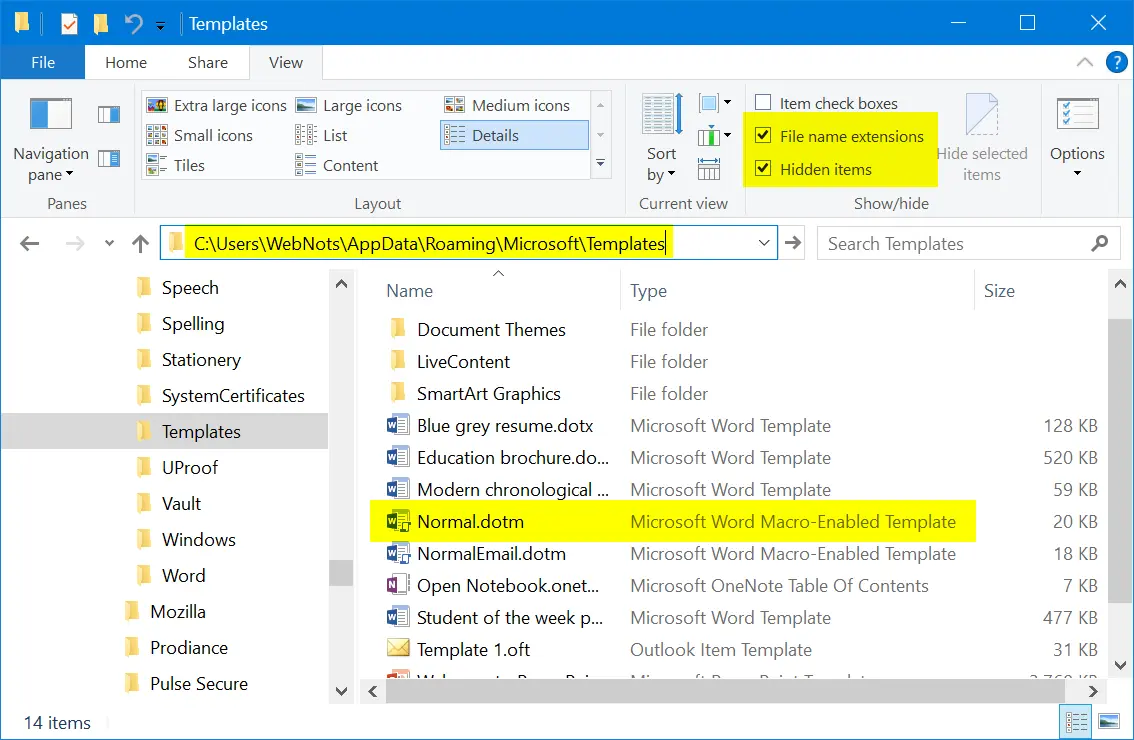
If you use Office on Mac, go to Finder and press “Command + Shift + G” to open “Go to folder” box. Type the following location and press enter key.
~/Library/Application Support/Microsoft/Office/User Templates/
After locating the template file in your PC or Mac, simply delete it. Now, open Microsoft Word to create a new Normal.dot/dotm/dotx file. Check whether this helps to solve the slow processing issues in Microsoft Word.
Related: How to quickly insert dividers in Microsoft Word?
Method #2: Disable Hardware Graphics Acceleration
In some cases, when you type on a Word document, it will lag for few seconds or longer from the moment you press the key. This will badly affect your productivity by causing delay and diverting your concentration when doing important work. Newer Office versions use hardware graphics acceleration to speed up the performance. However, slow computers often have limited hardware resources, which make Word less responsive. Follow these steps to disable hardware acceleration in Word:
- Open Microsoft Word and create a blank document.
- Click “File” menu and choose “Options” in the left pane to go to backstage view.
- On the “Word Options” screen, choose “Advanced” in the left pane.
- Look for “Disable hardware graphics acceleration” option at the right pane under the “Display” section and enable it.
- Click the OK button to apply your changes.

Restart Microsoft Word and verify whether the problem has been resolved.
Method #3: Disable Hardware Acceleration in Registry Editor
If Microsoft Word still performs slowly, it may be a good idea to perform changes in the registry. Note that modifying registry is not recommended and you may not have access in the administered computers. If you have access to registry editor then backup your data and follow the below steps:
- Press “Win + R” keys to open Run prompt. Type the command “regedit” and hit enter. Alternatively, use Windows search box and type in “regedit” to open Registry Editor.
- Navigate to the entry HKEY_CURRENT_USERSoftwareMicrosoftOffice16.0common.
- Note that 16.0 is the version of Microsoft Office 2016, your version could be different.
- Right click on the right pane select “New > Key” to create a new key under the “common” folder.
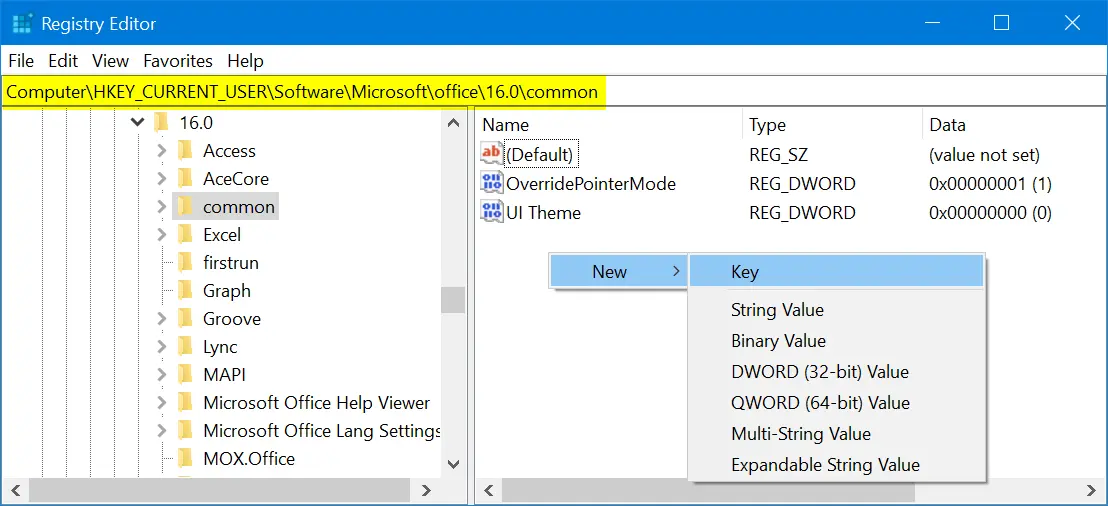
- Windows will create a key with the name as “New Key #1” with an option to edit. Type in “Graphics” for the name of the key.
- Click the newly created “Graphics” key and right click on the right pane. Select “New > DWORD (32-bit) Value” option.

- Type in “DisableHardwareAcceleration” as the name of the new DWORD value.
- Double click on the new DWORD and change its value from 0 to 1.

Close the registry editor and restart your computer. Check Word works smoother now.
Related: Fix slow Microsoft PowerPoint presentations.
Method #4: Install Latest Updates
If Microsoft Word seems to react poorly to any command for processing a task, you may need to look for updating to the latest service pack. The latest service pack may provide you with bug fixes and performance optimization. Microsoft releases service pack regularly, generally they are installed automatically if you have auto update enabled. Otherwise you need to check and update them manually. Often, by installing a new service pack, you can regain lost performance.

Note that Apple stopped supporting 32-bit applications from macOS Catalina. Hence the 32-bit Mac Word 2011 or 2016 apps will no more work on your Mac. Ensure to purchase Office 365 subscription to work with 64-bit compatible Office apps on your Mac.
Method #5: Update Your OS
Also ensure your Windows OS is getting automatic security updates to make sure that rest of the system is working properly. Microsoft updates Windows 10 automatically, however follow the below steps to check the status and manually update:
- Press “Win + I” keys to open Windows Settings app.
- Click on “Update & Security” section.
- Click on the “Check for updates” button to update your Windows 10 to the latest version.

If you have Mac, you can install the latest updates by following the below instructions:
- Go to “Apple menu” by clicking the Apple icon on top left corner of your Mac.
- Select “System Preferences…” and click on the “Software Update” option.
- Check any update is available and install the latest version.
Related: How to change embedded document name in Word?
Method #6: Reinstall Microsoft Office
If you use Microsoft Office regularly for creating complex documents, spreadsheets and presentations, there’s a possibility that it will become faulty or corrupted. You may remedy it easily by reinstalling Office package. Prepare your Microsoft Office DVD and product key to complete the re-installation process. Follow these steps to uninstall and re-install Office in Windows 10:
- Go to “Control Panel” and choose “Uninstall a program” under “Programs” section.
- Find Microsoft Office and click the “Change” button. Follow steps on the screen to remove the program.
- Use the installation disk or download from the Windows Store for re-installing again.
Note that Word 2000, 2002 and 2003 can be restored to original settings by choosing ‘”Detect and Repair” in the “Help” menu.
On Mac, you can simply drag the application file to trash bin and reinstall from the App Store.
Method #7: Delete “~.dot” or “~.doc” Files
When you open a document, Word will have a temporary file in the same folder indicated by the ~ (tilde) sign at the beginning. Generally, Word will delete them automatically when you save and close your document. however, if you accumulate lot of these temporary files, Word would become slow and sluggish. For example, if you zip the content when the document is open then the compressed folder will include the temporary file in addition to the original file. Follow these steps to cleanup the temporary files:
- Go to Windows Search box and type in ~*.dot.
- Hit enter and wait until you get all the files on your computer. Select all of them, right click and choose “Delete”.
- Repeat the process by typing in ~*.doc in the search box. Also select all of them, right click and choose “Delete”.
- You can also empty your Recycle Bin to save storage space on your PC.
Open Microsoft Word and make sure that the problem has been resolved
Method #8: Optimize Document Files
Often, less optimized document files cause slow performance. Check whether your document has plenty of embedded macros and remove any of them if possible. Many people also put high quality pictures with large resolution inside documents. You need to optimize the pictures by changing the dimension that matches the size of the page. You may also use Adobe Photoshop or Snagit to save these images in optimized format to reduce the file sizes without sacrificing the quality too much.
Method #9: Open Word in Safe Mode
One of the reasons for slow Word app is the corrupted documents. When you try to open corrupted document, Word will show a message like “Microsoft Word is not responding” indicating the problem. You can choose “Restart the program” option to cancel the current operation and try to reopen the file again.

If that does not help, then press “Win + R” keys and open Run Command box. Type “winword /safe” to open Word in safe mode. This will help you to speedup the document as Word will disable extensions and other unnecessary stuffs in safe mode. Sometimes, Word will also suggest to open a document in safe mode. Choose “Yes” to check whether the safe mode can help in improving the performance at least when processing that document.

Related: Fix slow Microsoft Outlook emails.
Method #10: Check File Lock
Some times people share the locked file in chat, emails or SharePoint. When you try to open locked file, Word will show you the “File in Use” warning and ask you to choose the action.

You may notice, slow response time in Word when you open and read locked documents. We recommend you to open the locked file in “Read Only” mode to open it faster. Otherwise, you can request the owner to share the file without edit lock.
Method #11: Disable Add-ins
If you use add-ins to enhance the functionalities then ensure to disable them when you have problem with Word.
- Go to “File > Options” menu in Word.
- Choose “Add-ins” to view all installed on your Word installation. you can click each add-in to check the function it does.
- Select the add-ins type from the “Manage” drop-down and click on “Go…” button.
- Uncheck the add-ins to disable them.
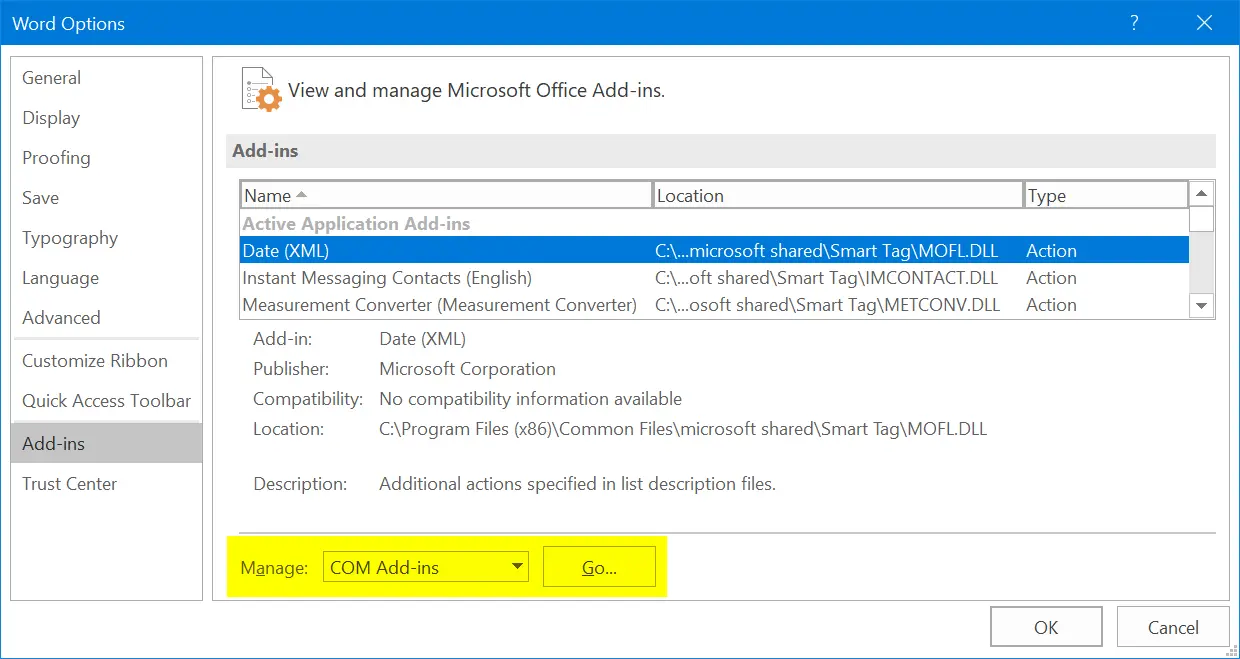
Check whether this helps to resolve your problems. You can enable the add-ins back any time when needed.
Conclusion
Microsoft Word is almost an essential utility in office workers and many user’s daily life. So when you experience slow response, typing delay or any other problem, it is a good idea to check all the above steps. This will ensure to fix the problems and focus on creating documents with improved productivity.
One common problem faced on many computers is the slow launching or termination of MS Word. This problem is usually due to a corrupted or problematic «Normal.dot» template. The «Normal.dot» template is the location where word saves all the default settings (e.g. font type, font size etc.) and it is used with every word file –blank or not- you open.
This tutorial fixes the following problem(s) of Word: Word is to slow to start, load documents or close.
To solve these problems find the word templates location folder and delete the «Normal.dot» (or «Normal.dotm» if you have Word 2007/2010) file. To do this follow these steps:
1. With your MS Word application closed, go to Start > Run
2. At the «Run command box» copy and paste one of the following commands according to your operating system version and then press OK
a. For Windows XP:
- %USERPROFILE%Application DataMicrosoftTemplates
b. For Windows Vista / Windows 7 /Windows 8 & Windows 10:
- %appdata%MicrosoftTemplates
2. Locate the file called «Normal.dot» if you have Word 2003, or the «Normal.dotm» file if you have Word 2007, 2010, 2013 or a later version of MS Office and delete it. Don’t worry about the deletion. Next time you open MS Word, a new, clean Normal Template (Normal.dot, Normal.dotm), will be created.
Now open MS Word and enjoy writing! *
* Additional help: If after performing the above, the Word is still slow when launching or closing then restore it to its default settings by following the steps below:
a. Close Word.
b. Open the Registry Editor. (To do that, at «Run» command box, type REGEDIT and press Enter.)
c. At Registry Editor, navigate to the following registry location according the installed Word (Office) version:
If this article was useful for you, please consider supporting us by making a donation. Even $1 can a make a huge difference for us in our effort to continue to help others while keeping this site free:

If you want to stay constantly protected from malware threats, existing and future ones, we recommend that you install Malwarebytes Anti-Malware PRO by clicking below (we
do earn a commision from sales generated from this link, but at no additional cost to you. We have experience with this software and we recommend it because it is helpful and useful):
Full household PC Protection — Protect up to 3 PCs with NEW Malwarebytes Anti-Malware Premium!
As proposal writers we spend a lot of time in Microsoft Word. So If Word becomes slow or unstable it multiplies the time and effort, not to mention frustration, it takes to complete our work. Sometimes the slowdown is outside of our control – such as the unexpected result of a Microsoft Office Update. But there are also a number of factors we can control to help speedup Microsoft Word and improve its performance.Word performance can be affected by both factors outside of Word as well as settings within Word. If Word is ended abruptly it can leave behind invisible ‘temp’ files that can continue to cause problems. Temp files can also be created by ‘Windows Defender’ and other security applications.Sometimes a Word document or template or Word’s own Normal template can become corrupted. Add-ins and start-up templates can also sometimes conflict with Word’s performance.The following is a list of Windows System troubleshooting steps to consider:
- Remove Temp files by running ‘Disc Clean-up’
- Delete Normal Template (Note: before Deleting Normal.dotx, consider renaming and archiving it AND/OR contacting your IT Department. If you or your organization has a custom Normal.dot, request it be reinstalled.)
- Reboot
- Set Ribbon Folder as ‘Trusted Location’ in Word Options
- Set Ribbon Folder as ‘Excluded’ in Windows Defender
- Check for and disable other Word add-ins
- Check for and remove Templates from Word Start-up Folder
Since settings in Word can also diminish performance, it is worth reviewing your current settings and content elements. Many settings are found in File > Options while others are specific to content elements such as tables, images and objects.
The following is a list of Microsoft Word troubleshooting steps to consider:
- Save Word in the version that you are using (if you see compatibility mode in title, do a save as and click the ‘advanced options’ button to bring it to current version.)
- Remove or limit timing of background saves
- Disable auto-repagination
- Compress images
- Make images ‘inline’ instead of ‘floating’
- Use styles instead of direct formatting
- Unlink objects if not needed (sometimes pasting from Excel or other apps creates an unintentional link)
- Turn off auto-update of links
- Set Table properties ‘Text-wrapping’ to ‘None’ (text-wrapping makes tables act more like shapes, but this can cause instability when inserting rows or breaking across pages)
- Remove From My Forums
-
Question
-
I upgraded my Dell Inspiron 2GB ram E1505 laptop to Windows 7 Professional and Word 2010. I recently began editing
a Word document that was created in a previous version of Word 2007, about 12 pages with 9000 words and more than 10 drawing canvases. The keystroke response time to do anything is excruciatingly slow. Editing the drawings is extremely slow.
Adding or deleting single letters in sentences takes about 2 seconds per keystroke. Each letter added or deleted seems to require that the whole document redisplay. Scrolling up and down takes multiple seconds per page per key stroke.
Both of my attempts to work around the situation failed.
First, I created a new document and selected all the information from the old document and pasted it into the new document, but performance did not improve.
Second, from Jennifer Zhan’s prior posting, I unchecked the Trust Center options, but performance did not improve.
Unless I can address this performance issue very quickly, I will likely be forced to remove Office 2010 from my computer, go backwards,
and reinstall Office 2007.Any assistance will be appreciated.
Answers
-
Hi,
First, try to start Word in safe mode [hold ctrl key while startup] to see if this issue is caused by some add-ins. If it works well in safe mode, disable all add-ins. How to do this, see here:
http://office.microsoft.com/en-us/outlook-help/enable-or-disable-add-ins-in-office-programs-HA010034127.aspx
Also you may try some other methods:
Reset the Word data key in the Windows Registry
- Click Start and then click Run. In the
Open box, type Regedit and then click OK. - Open the following registry key: HKEY_CURRENT_USERSoftwareMicrosoftOffice14.0Word
- Under the Word key, click the Data subkey.
- On the Edit menu, click Delete. Click
Yes if the following message appears: Are you sure you want to delete this key? - On the Registry menu, click Exit. Re-start Word.
Repair or replace damaged or missing fonts
Damaged or missing fonts can cause the issue that word runs slowly when you edit in Word. To correct this problem, remove and reinstall the fonts.
In addition, if you use printer on this PC, try to delete and reinstall your printer driver.
If all of above has no avail, I suggest you uninstall your office 2010 and re-install it.
-
Marked as answer by
Monday, August 23, 2010 2:26 AM
- Click Start and then click Run. In the
Did you experience Microsoft Office Excel or Word documents opening very slowly or may appear to stop responding (hang) when you open a file from a network location? This issue ” Word, Excel or PowerPoint application is loading slower ” mostly caused due to some installed add-ins that load with Word/Excel/PowerPoint.
Again if the Word/Excel sheet freezes while loading from a network shared location, then there is chances some problem with the network location that lost the connection during the time that your Office program is opening the file. That cause you need to check Network connectivity and perform these Network Troubleshooting steps.
If you are experiencing “Microsoft Word, Excel or PowerPoint ” slow loading problem, Word/Excel document files take a relatively long time to open, freezes when I try to exit here some solutions you may apply.
Note: If you notice Not only Ms office application other apps not responding on your System, Even Computer freezes Try these tips to Speedup Windows 10 PC performance.
Disable installed add-ins
As discussed Installed Add-ins are the most common reason for Word, Excel or PowerPoint application slow loading. If you have installed tens of add-ins from the Office Store, disabling unwanted add-ins, especially add-ins that load with Office applications, can significantly improve the load time of your Word, Excel and PowerPoint applications. lets Disable Installed Add-ins that may fix the problem for you.
Note: As we are facing a problem opening Word document, we need to start Word/Excel in safe mode to Disable Add-ins.
- Find the shortcut icon for your Office application.
- Press and hold the CTRL key and double-click the application shortcut.
- Click Yes when a window appears asking if you want to start the application in Safe Mode.
- Now from File menu, click Options. then Add-Ins.
- In the Manage list, click COM Add-Ins, and then click Go.
- Here If an add-in is listed in the COM Add-Ins dialog box, clear the add-in check box.
- And If more than one add-in is listed, clear only one add-in check box at a time. This procedure helps determine which add-in is causing the problem.
- Click OK to close the COM Add-Ins dialog box.
- On the File menu, click Exit.
- Now open Word document check this helps.
Note: To enable the add-in again, check the box next to it and then click on the OK button. You might need to restart the Word/Excel/PowerPoint to enable or disable the add-in.
Note: If Excel does not open when double-clicking an Excel file, Then open excel (or in safe mode)
- File → Options
- Go to Advanced → General
- Make sure that Ignore other applications that use Dynamic Data Exchange (DDE) is not checked.
Repair MS Office application suite
This is another producer to determine the problem if MS office itself gets corrupted, missing files that cause other applications not to start properly even stuck opening. If Office application such as Word or Excel isn’t working correctly, Here how to repair MS office application.
- On start, menu search Type control panel and select the desired option.
- From Small icon view Open programs and features.
- Right-click on installed office Application select change.
- On the next screen select the radio button “Repair” and Continue to start the repair process.
- This will take a long, to complete the process, After that restart windows and check Office applications working properly.
Check with Different User profile
Sometimes corrupted, user account profile causes Office applications not to start correctly, log in to the different user account and check this helps. If you don’t have another user on your PC, Here how to create a user account on windows 10.
- Open the command prompt as administrator.
- Type command net user [user name] /add
- To add the user on local group administrator use the command “net localgroud administrator [user name] /add“
- Log off from the current user account and login with the newly created user account.
- Open Word/excel document and check this helps.
Again for some users changing the Default printer from Control PanelHardware and SoundDevices and Printers help to resolve the issue.
For some other users Change the Print spooler service “manual” helps to fix the problem.
Did these solutions help to “Make Microsoft Office Word/Excel Load Faster“? let us know on the comments below, Also read
- MS Outlook not responding, Freezes frequently? Here 7 Working Solutions to Fix Outlook problems!
- Microsoft Office 2019 released for Windows and Mac! Here what new (Features)
- How To upgrade and Install Microsoft office professional plus 2016
- Microsoft Outlook Stuck on Loading Profile? Here how to fix it
- New Features And improvements of Microsoft office 2016 Professional Plus
Here’s a question we got from a reader:
Lately, i am noticing some slow down in my Microsoft Word software performance, this is visible mainly when starting up the software. My feeling is that some additional packages i have installed are causing this. Any ideas from your side?
Why Microsoft Word is slow?
Microsoft Word’s performance is in general reasonable fast but it can definitely deteriorate and significantly slow down if bloated with add-on software or running on dated or inadequate hardware. Same can happen in other MS Office apps, such as Excel and Outlook.
Speed up Microsoft Word if it’s slow
Please proceed as following to speed up Microsoft Word performance on Office 365:
# 1 – Disable Word Add-ins
Microsoft Office software has the capability to host Add-In components. These small software programs extend the capabilities of the standard Office package to improve user productivity. In a way, you can think of those little programs as browser Add-ons, but just for Microsoft Office. The caveat is that sometimes, these Add-Ins slow Word, specially at startup, as the programs are loaded when Word is started causing a noticeable delay. This is probably the most common performance hiccup of Microsoft Office program, so it’s applicable also to Excel, PowerPoint, Access and Visio.
If you notice that Word is slow when your computer starts up, you might want to look into your installed Add-Ins and temporarily disable the ones you don’t currently need. Here’s how to accomplish that:
- Open Microsoft Word.
- Hit the ‘File’ button at the top right and choose ‘Options’ at the left side of the screen.
- Now, click on Add-Ins at the left side of the Windows called ‘Word Options’.

- Now, Choose ‘Go’ after selecting Manage ‘COM Add-Ins’ at the bottom of the same window.

- Uncheck the Add-Ins you don’t need in order to disable them.
- Hit OK.
- Close Microsoft Word.
Now start Word and see if you notice fast startup performance. If so, you might want to remove the disabled Add-Ins altogether, this will be covered in the next section.
# 2 – Remove unwanted Add-ins
Similar to the previous tip, however, instead of unchecking the COM Add-Ins entries to disable proceed as following:
- Go ahead and highlight the entry to uninstall
- Hit Remove.
- Repeat for all required entries.
- Once done hit OK.
# 3 – Always work on local documents (rather than remote)
Retrieving document and saving changes into files stored in remote locations (OneDrive, SharePoint libraries, shared folders etc’) is typically time consuming and depends on your network performance. Therefore, If possible, ensure that the documents you are working are stored in your local drive. Once done, sync your changes into the network location or save a new version of your document so you can share with others contributors or reviewers.
Note: If possible, also ensure that the local drive storing your documents is uncompressed.
# 4 – Disable Auto Correct options
By default, Word checks your spelling and automatically correct any mistakes found in your text. Very useful feature, but has a performance penalty.
To skip auto corrections, proceed as following:
- Navigate to Options, then navigate to the Proofing tab.
- Navigate to the lower section of the tab, and uncheck “Check spelling as you type” and “Mark grammar as you type”.
- Hit OK.
Note: you’ll need to check your spelling and Grammar manually (Review tab>> Spelling and Grammar).
# 5 – Disable Screen Tips
Screen Tips help you receive additional information and guidance when you hover on hyperlinks, comments and so forth. This is useful, but might impact Word performance.
To cancel ScreenTips display in your Word document, proceed as following:
- Navigate to Options, then in the General tab, navigate to the UI options section.
- Then, under ScreenTips style, select Don’t Show ScreenTips.
- Hit OK.
# 6 – Clean Temporary/Unwanted Files
Quite often, cleaning up temporary/unwanted files can significantly improve your personal computer performance. Freeware solutions such as CCleaner and TreeSize Free can be specially helpful. Don’t forget to clean both your Temporary files and the Registry. You could also remove unwanted software that are installed in your system using the Add/Remove Programs panel.
# 7 – Consider an hardware upgrade
Couple of readers contacted me reporting slow performance issues when working with large files which included pictures, which caused Word to get stuck. One of the solutions would be to upgrade your computer RAM memory to 8 or 16 GB, specially if you run multiple programs in parallel or do some intensive work on image and video editing software.
Hopefully, these steps should make Word much faster. If you don’t notice anything different, leave us a comment below.
Word 2007 — and now Word 2010 — on my Vista laptop has often been very slow to load a document and to respond to a document command (like Save). I’ve been blaming Vista…
But when I started to edit a 300+ page Word 2010 document on my Vista laptop, the unresponsiveness was going to be a huge productivity drain. So off to Google to see if there was an answer to this problem. And there is! And it’s not related to Vista at all, but to how a Word document interacts with the default printer. If the default printer is a networked printer, then there can be response issues.
In my case, the default printer is not only a networked printer, but when I opened this 300+ page document, the printer was turned off (it was a Sunday and I don’t use the printer all the time, especially on weekends).
After following the advice of people in this forum thread, I changed my default printer on the Vista laptop to Adobe PDF (Microsoft EPS works well too, I believe). And guess what? The document responded beautifully! No more achingly long Not responding messages in the Word 2010 title bar; no more watching the ‘spinning wheel of death’ (as I like to call it) while waiting and waiting for the Word document to respond because it was trying to talk to my network printer.
Brilliant.
But I have to question WHY Microsoft still ties things like Word documents so closely to the default printer. Most of us have many ‘printers’ listed these days — many of which aren’t even printers, but instead are printer drivers. If a network printer is set as the default and it can’t find it, then why don’t we get a message to tell us to change to another printer driver so we can work in a fully responsive document?
[Link last checked April 2011]


